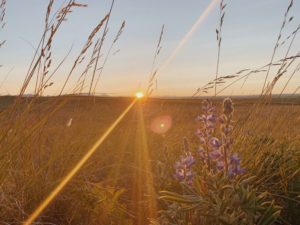
The concept of home is innately complicated yet somehow simple. The word itself conjures up nostalgia and feelings of overwhelming warmth. The saying “home is where the heart is” is accurate at the root, but doesn’t convey that home can be a collection of places and people scattered across experiences. Moira, a fellow WRFI classmate, mentioned over trailwork in Alberta that you can leave pieces of your heart everywhere you go. The place you were born, where you go to school, the place you shared belly laughs over a pan of warm gooey brownie batter in the backcountry or someone that makes you feel at home. This course has me analyzing where my homes are while simultaneously uncovering new places to leave a piece of my heart as I learn and grow. It should be mentioned that home is also where I long to be on those “type two fun” days; where you struggle through rain, hail, or downed trees just to make it out stronger -with a great story – on the other side.
Mike Bruised Head, a chief with the Kainai First Nation, welcomed us into his home and culture in Standoff, Alberta where he discussed his version of home during our stay. Mike told our group that he was born on the Blood Reserve, as was his family, just a stone’s throw away from his current house. He is inherently connected to this place through language, culture and tradition. Mike said that throughout his life and travels, he will always come back to the Blood 148 Reserve because of that unique connection to place. Connection to place is a common belief in the Native and First Nations people who we were fortunate enough to meet. This is one of the reasons respect and reverence runs so deep for the land and all of its inhabitants, plants and animals alike. It’s the connection to place that keeps people like Mike Bruised Head returning and fighting for land and rights – over environmental and political reasons.
For many First Nations and Native people, home had to be more than one place because of issues like boarding schools, where they were sent from their homes as children to become culturally assimilated and stripped of their culture, or being forced off of their land. Pauline Matt, a Blackfeet herbalist who we met with discussed her connection to the land and the danger it was in as we visited her home just outside of Browning, Montana. Oil companies proposed 500 wells along the Rocky Mountain Front on the land she and fellow Blackfeet members call home. As a native herbalist, Matt considers the land to provide for her spiritually and emotionally; fracking would clearly disrupt the purity and sanctity of the place. She took matters into her on hands and protested the proposed wells by walking across Glacier National Park to pray for the waters and ask for health and healing. It was a long battle for Matt to raise awareness and draw attention both locally and nationally, but her work paid off when the oil companies backed out in the weeks following, calling Matt a “hateful woman.” She simply replied that “when you love the land, you have to protect it.” It’s the connection to place that empowered Matt to fight for what she believes in.
A connection to place is fully encompassing and truly shows the regard held for an extremely special spot, whereas ‘home’ suggests it’s rooted in one place, unable to transfer or multiply with gained experiences and perspective. I believe I’m connected to places in my life that aren’t confined to the place I was born or grew up; where I grew up on the lakes in Wisconsin, where I go to school in Vermont, where I shared Snickers bars and danced to Bob Marley in the Himalayas, and mostly, where I feel a deep sense of connection and happiness. Coming away from this course, I’ll be leaving a piece of my heart in the Crown of the Continent.